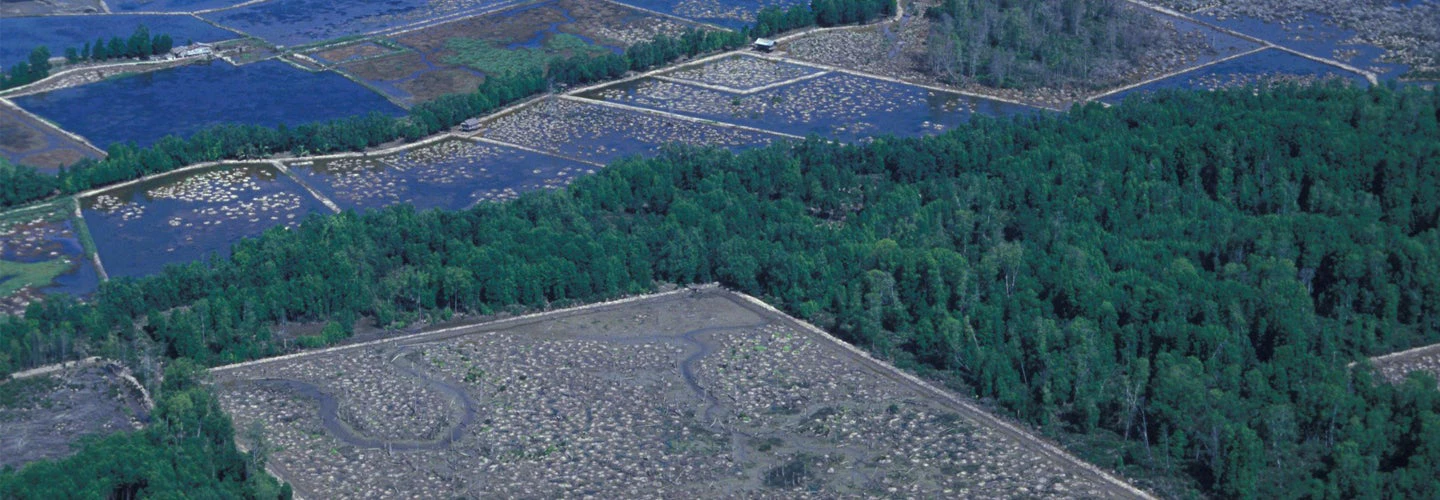 Aerial view of forest and fields. Indonesia. Photo: Curt Carnemark / World Bank
Aerial view of forest and fields. Indonesia. Photo: Curt Carnemark / World Bank
Healthy forests support the foundations on which humans, wildlife, and ecosystems can thrive.
Investments in forests are investments benefiting people, economies, and our planet. The forest sector accounts for 1% of global jobs, employing more than 33 million people. Beyond providing jobs, forest landscapes provide timber, fiber, fodder, and energy that feed the wider economy. They are also important for food security and provide a social safety net to rural communities.
Well-managed forests are an effective tool to helping end poverty on a livable planet, especially considering that over 90% of people living in extreme poverty rely on forests for some of their livelihoods. Forest landscapes also cover more than 80% of the area that Indigenous Peoples occupy, many of whom see forests as the source of their livelihoods, food production, and cultural identity.
Yet, forests remain under threat.
In parts of the world where forests remain unregulated and governance structures are weak, we see devastating levels of deforestation, often resulting from agricultural expansion.
As a result of deforestation, the world has lost an area the size of Ethiopia since 2000.
This should be a wake-up call. When we neglect forests, we essentially give up one of our most effective tools for tackling climate change and nature loss, while simultaneously improving lives and growing economies.
Degraded forest landscapes also undermine action on climate change. Forests are the earth’s second-largest natural storehouse of carbon, second only to the ocean , helping maintain Earth’s carbon balance and reduce the impacts of climate change. Approximately 12% of the world’s greenhouse gas emissions are attributed to deforestation and forest degradation.
The effects of deforestation on poverty are equally concerning, leading to a loss of livelihoods, food insecurity, and often conflict and displacement. Deforestation and encroachment into natural areas also increase contact between humans, livestock, and wildlife, which in turn increases the risk of infectious diseases and pandemics, including SARS, Ebola, and HIV.
The road ahead may be mired with institutional and financial hurdles. But here are four considerations to chart a path to a nature-resilient future:
- Better Planning: Single-sector approaches to development challenges are not enough. Integrated land-use planning can help – this means considering both the natural and human systems that depend on a landscape, to sustainably manage a variety of land uses. We are taking this approach through our work on PROGREEN – a global partnership of the World Bank, Germany, and Sweden – that supports countries with the development of such plans across forest, oasis, and savannah landscapes around the world.
- Better Management: This starts with laying the regulatory groundwork on which countries can conserve and grow their forests and the ecosystem services they provide – from clean air and potable water to flood and erosion control.
- Better Business: When forests are managed sustainably, industries and local economies flourish, including nature-based tourism. Globally, tourism levels are on the rise, with eight billion tourist visits to protected areas each year. Agroforestry is another industry that allows local communities to sustainably commercialize forest products, such as fodder for livestock, food products like fruits and nuts, as well as timber.
- Increased Inclusion: Forest-dependent peoples, who are disproportionately represented among the world’s poor, often lack access to markets and public services. Amid deepening climate and nature crises, deliberate efforts to extend the social safety net to forest dependent people can help keep them out of poverty, especially in the short term.
In addition, there are two underlying issues that have the potential to derail our efforts, which we need to overcome. Firstly, we need better and freely accessible data to make the case for investments in forests as a means to achieving economic growth. Prioritizing natural capital accounting – the systematic measuring, valuing, and managing of a country’s natural resources and ecosystem services – can equip finance ministries with the evidence needed. For example, with the incoming implementation of the European Union’s Deforestation Regulation, companies and governments will need to be able to monitor, trace, and report on data that demonstrates deforestation-free practices associated with the export of agricultural commodities and timber into the EU.
Secondly, we need additional finance to invest in forest landscapes. To meet future climate, biodiversity, and land degradation targets, public and private actors will need to scale up their annual investments by at least four times over the next three decades. By 2050, total investment needs will amount to US$8.4 trillion, cumulatively, reaching over US$536 billion per year. This financing can be mobilized in part from existing domestic resources including by repurposing environmentally harmful subsidies, which currently comprise 8% of global GDP. But this hinges on creating the regulatory environment that is supportive of strong small- and medium-sized businesses investing in the forest sector.
The World Bank is committed to helping countries harness the immense potential held by their forests . We will continue to work on the frontlines of the nature crisis to sustain a livable planet for generations to come.


Join the Conversation